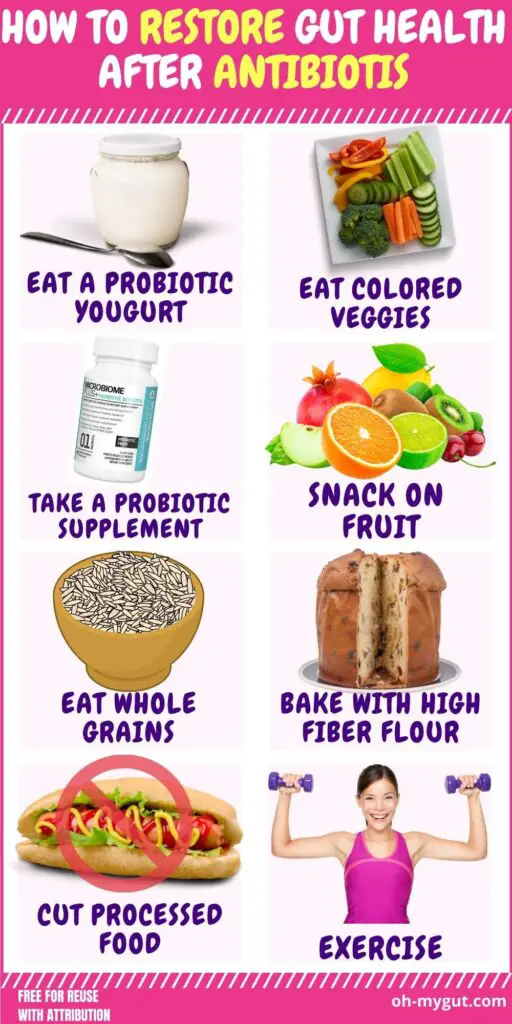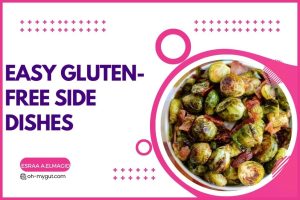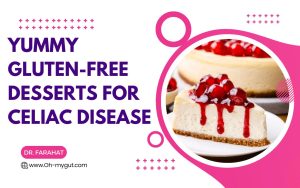Restoring Your Gut Health After Antibiotics: 8 Actionable Steps.
Taking antibiotics for any reason can HARM your gut health, they can kill the beneficial micro-organisms living inside your gut.
it is enough to know that antibiotic-associated diarrhea occurs in 19% of children after taking antibiotics (ref).
Reading and searching for ways to restore gut health doesn’t work!
YOU HAVE TO TAKE ACTIONS.
I created this comprehensive, step-by-step guide for you to take active steps you can implement today to improve your gut health.
- Knowing doesn’t improve your gut health, Taking action does.
- My goal here is not just to make you read and run. I want you to take easy and clear steps to improve your gut health.
- This is what really works, evidence based.No fluff here. follow our comprehensive guide that will restore your gut health once and forever.

(Step #1) Repopulate your gut with healthy bacteria (probiotic food).
Antibiotics can kill your friendly gut bacteria. and The best way to replenish is to re-inoculate them.
The safest way is to eat probiotic-rich foods.
Examples:
1- Probiotic yogurt:
It is the best source of friendly bacteria. Also, it has many other health benefits such as reducing diarrhea and improving bone health.
But, probiotic bacteria may become killed during the processing. So, make sure to purchase The right type of yogurt. you can search amazon for “probiotic yogurt”.
#AD: Our recommended product is Activia vanilla probiotic yogurt
2- Kefir:
Kefir is a probiotic milk drink, Made by adding kefir grains to cow’s or goat’s milk. Other health benefits of kefir include (source):
- It may improve bone health.
- Helps with other digestive problems such as bloating and indigestion.
- Protects against infections.
Also, Kefir is a MORE POTENT probiotic than yogurt and it is well tolerated by people who have lactose intolerance.
3- Other Probiotic foods you can try.
- Tempeh and Natto: Fermented soybean products.
- Traditional Buttermilk.
- Miso: a Japanese seasoning.
- Pickles (gherkins): cucumbers that have been pickled in salt and water.
- Kimchi: a fermented, spicy Korean side dish.
Kombucha: a fermented black or green tea drink.

- Take a daily serving of either a probiotic yogurt or Kefir for the next 2 weeks.
(Step #2) Include more colored veggies & eat them before your meal.
The most effective strategy to restore your gut health after the antibiotic is to eat more fiber.
Eating “colored” veggies provide you with more vitamin and fiber. Try to eat a wide vanity of green and colored vegetables.
And a good pro tip is to eat them before meals. One study showed that you will obtain 23% more vegetables if you ate your veggies/salad before your meal (reference).
Also, when you eat salad or vegetable soup before your meal, you’ II more likely to eat fewer calories during the meal.
So, a wide variety of veggies can help you restore your gut health by:
- providing more fibers and prebiotics to your friendly b actor.
- providing a wide variety of vitamins essential for your colon health.

- Starting from today, for at least a week, eat a big dish of colored salad or vegetable soup, before for your main meal
- Here are 12 colored salad recipes to start with → No Excuse
(Step #3) Try A Probiotic, Prebiotic, and Enzyme Supplements
A] Probiotic supplements:
Antibiotics can kill the beneficial bacteria inside your small intestine and colon. Probiotics are live bacteria or yeast that can restore the balance inside your gut.
Many health benefits you can obtain from probiotics especially after taking antibiotics:
- Probiotics can Strengthen intestinal immunity: probiotics augments the cell junctions between the cells lining your intestine. This acts as a “barrier” against the bad microbes which want to invade your body (ref)
- Probiotics decrease the risk of antibiotic-associated diarrhea: for example, in this study, probiotic use with antibiotics decreased the risk fo antibiotic-associated diarrhea from 19% to only 8% in children.
- Fights the Growth of bad bacteria and microbes.
- Decrease inflammation inside your intestine: probiotic bacteria decreases the production of a substance that mediated inflammation called “cytokines” (ref).
- Decrease intestinal Hypersensitivity.
- Help the regulation of digestion, absorption, and bowel movements: the greatly helps better gut health and prevent indigestion and bloating
Although the scientific evidence is still not so strong, Probiotics seem to help your gut health, especially after antibiotic treatments.
The scientific evidence:
Probiotics still not regulated by the FDA (Food and drug administration) nor recommended by the AGA (American Gastroenterology Association).
This is because it is still considered as a dietary supplement by the FDA. and there are no large controlled trials assessing its efficacy.
However, Many gastroenterologists and other health authorities such as the UK NHS recommend its use in some gut health conditions caused by antibiotics such as Antibiotic-associated diarrhea and Clostridium difficile diarrhea.
Should you take probiotics during or after antibiotics?
if you are still on antibiotics, you can take probiotics. but you have to take them 3 to 4 hours apart as antibiotics may kill the live probiotic bacteria.
But if are now off antibiotics and just want to restore your gut health, taking a probiotic supplement for at least a month will help.
What is the best probiotic strain to take after antibiotics?
Unfortunately, research about probiotics, the effects of specific strains, doses, and duration is still lacking. No current specific recommendation about the best probiotic strain, dose, or duration.
A large review study found that 2 probiotic species are particularity effective (ref):
- Lactobacillus species.
- Saccharomyces spp (a yeast that is not affected by antibiotics)
(B) Take a prebiotic supplement.
A probiotic means living beneficial bacteria inside your gut. While a prebiotic is the “food” the probiotic bacteria needs.
Probiotics are essentially “dietary fibers” and plant polyphenols. They perform 2 major functions:
- Helping the friendly bacteria to grow and beat the pathogenic bacteria.
- Helping the friendly bacteria to produce nutrients and breakdown complex molecules. This helps us with digestion and absorption.
- Helping the restoration of healthy gut bacteria after antibiotics.
You can obtain probiotics by:
- Eating “prebiotic foods n.
- Taking a “prebiotic supplement”.
Examples of prebiotic foods:
1- Chicory Root: a great source of probiotics, As 47% of its fibers comes from a prebiotic called “inulin”.
2- Garlic: contains a probiotic, inulin, and fructooligosaccharide (FOS).
3- Onions, leeks.
4- Apples and Bananas.
5- what Bran.
6- oats.
7- Barley.
8- Dandelion greens.
9- Asparagus.

- Use a probiotic and a prebiotic supplement Today and for one month
- Our recommended: Seed daily synbiotic. The most reputable probiotic in the market nowadays.
(Step #4) Eat 2-3 fruit snacks a day.
Another easy way to replenish and feed your friendly gut flora is by eating fruits.
Snacking on fruit has many health benefits:
- It delivers more fiber which is our main strategy to replenish your gut flora.
- A very good source of vitamins.
- Provides fullness.
- Also, they are tasty and portable.
Recommended fruits:
- Apples
- Bananas
- Tomatoes
- Avocado
- Grapefruit
- Kiwi
- Oranges
- Coconut

- For the next week, Eat at least 3 types of fruit snacks every day.
(Step #5) Go “Whole” grains.
When you eat “refined grains“, you will miss:
- The fiber-rich hull of the whole grain, and
- The vitamin-rich germ.
So, it is a bad idea to over-consume refined grains. Instead, try to make use of fibers and vitamins present in whole grains.
Try to eat a diversity of whole-grain meals. The more diverse you are, The better it is for your gut bacteria.
Examples of whole grains to include in your meals:
- Brown rice.
- Barley.
- Bulgar (cracked wheat)
- Buckwheat
- oatmeal
- Millet
- popcorn
- whole-wheat bread, pasta, or crackers.
NOTE: if you’re planning to go completely “whole grain”, you have to take folic acid and a B vitamin. As whole grains are not fortified as refined grains (reference).

- For the next week, eat a once-daily whole-grain meal, 20 recipe ideas HERE.
(Step #6) Bake with high fiber flour.
When you bake muffins, bread, or any other bakings, choose a flour That will promote
your friendly gut bacteria.
Replace your white flour with “whole-wheat pastry flour’?. This whole-wheat flour
has B times more fiber Than white flour.
Also, you can use high-fiber Non-wheat flours such as!
- Buckwheat flour
- Almond flour.
- Barley flour.
- Hazelnut flour.
- Chickpea flour.

- Bake your bread/muffins this week with “whole-grain pastry flour” for one month.
(Step #7) Cut out processed food and sugar.
One of the best way to keep your gut healthy is to cut high sugar foods and processed meat.
processed meat is linked to increased risk of colon cancer (reference).
stay on healthier alternatives as cutting high sugar and processed foods is the best long term strategy you can implement.
(Step #8) Exercise.
doing any form of light to moderate exercise on daily basis can greatly improve your gut health.

- Do brisk walking for 30 to 60 minutes every day.
- Ride a bike.
- Do Yoga.
Now, It’s your Move, Actionable checkliskt to restore your gut health after antibiotics:
- Take a daily serving of either a probiotic yogurt or Kefir for the next 2 weeks.
- Starting from today, for at least a week, eat a big dish of colored salad or vegetable soup, before for your main meal Here are 12 colored salad recipes to start with
- Use a probiotic and a prebiotic supplement Today and for one month Our recommended: Microbiome plus + gastrointestinal combo, it contains a prebiotic & probiotic at the same package.
- For the next week, eat at least 3 types of fruit snacks every day.
- For the next week, eat a once-daily whole-grain meal, 20 recipe ideas HERE.
- Bake your bread/muffins this week with “whole-grain pastry flour”.

17+ Easiest Gluten-Free Sugar Cookies Ideas
Discover the easiest gluten-free sugar cookie ideas. Perfect for celiac disease and gluten sensitivity. Simple, delicious, and safe recipes everyone will love.

17+ Tasty Gluten-Free Pasta Salad Ideas
Discover a collection of delicious gluten-free pasta salad ideas perfect for any occasion and every taste.

17+ Super Tasty Gluten-Free Side Dishes Ideas
Explore a variety of super-tasty gluten-free side dishes. From roasted vegetables to quinoa salads, find healthy and delicious options for your gluten-free diet.

18 Easy and Tasty Low-FODMAP Brownies For IBS.
Discover easy and tasty low-FODMAP brownies for IBS that satisfy your sweet tooth without triggering symptoms. Perfect for everyone!

16+ Tasty Low-FODMAP Appetizers For IBS
Discover tasty low-FODMAP appetizers for IBS that are delicious, easy to make, and gut-friendly.

16+ Delicious Low-FODMAP Desserts for IBS
Discover a variety of delicious low-FODMAP dessert ideas perfect for those with IBS, including cookies, cakes, and more.

17+ Super-Healthy Low-FODMAP Recipes for Vegetarians With IBS
Discover super-healthy low FODMAP recipes for vegetarians with IBS. Perfect for delicious and easy-to-digest meals that suit your dietary needs.

17+ High-Fiber Lunch Ideas For IBS-Constipation
Explore the best low-FODMAP and high-fiber lunch recipes for IBS with constipation. explore the tasty and FODMAP-free delicious recipes

17+ Yummy Gluten-Free Desserts For Celiac Disease
Discover yummy gluten-free desserts perfect for celiac disease. Enjoy delicious, safe, and easy recipes.

17+ Delicious Smoothie Ideas For GERD & Acid Reflux
A healthy banana oat smoothie for GERD, featuring rolled oats, yogurt, and banana for a creamy, soothing drink.

17+ Tasty High-Fiber Lunch Ideas For Chronic Constipation
Discover tasty high-fiber lunch ideas for constipation. Delicious, nutritious meals to support your digestive health and keep things moving smoothly.

19+ Soothing Breakfast Ideas For A Sensitive Stomach
Discover easy breakfast ideas for sensitive stomachs with these gentle and delicious recipes.













